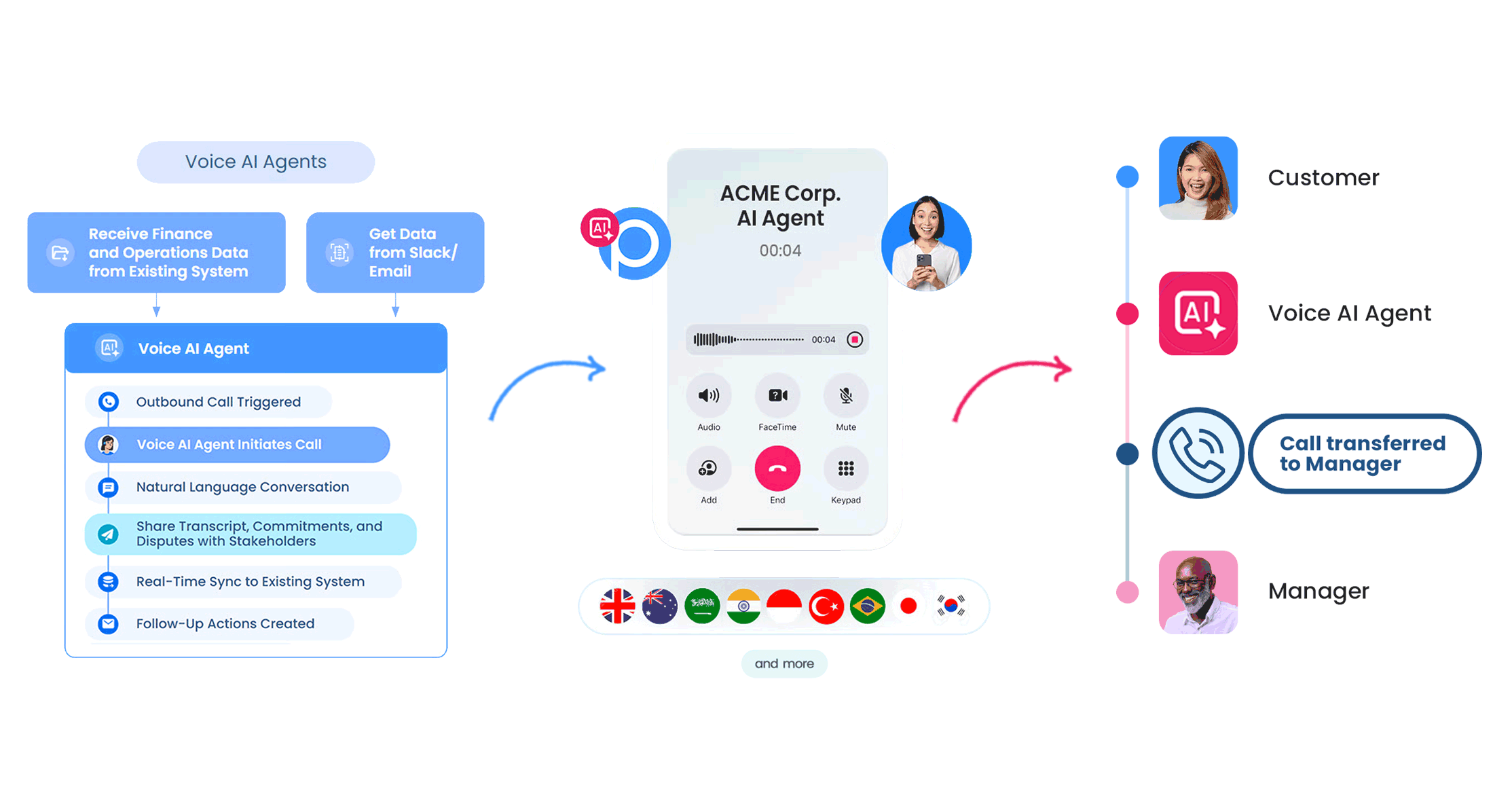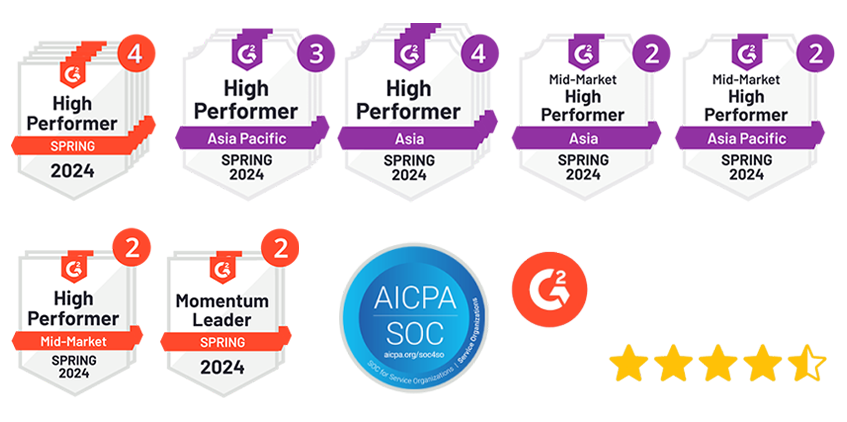AI voice assistants have moved beyond simple command-and-response interactions to become sophisticated conversation partners. These systems now feature Large Language Models with over a trillion parameters, enabling conversations that feel remarkably natural and human-like.
Customer preferences reveal an interesting contradiction. Research shows that 59% of consumers still prefer phone as their primary channel for customer support, yet 66% would rather use self-service options than speak with an agent. This creates a clear opportunity for AI voice assistants to bridge the gap between human interaction and self-service efficiency.
Modern AI voice assistants address this need by offering hands-free operation for essential tasks like sending messages or setting reminders. These systems continuously learn from interactions to improve their accuracy and efficiency. Most importantly, conversational AI voice assistants can significantly reduce customer wait times by quickly providing information or directing users to appropriate resources.
This guide examines what actually delivers results in the AI voice assistant landscape of 2025. We’ll explore their current capabilities, practical benefits, and provide guidance on selecting the right solution for your specific requirements.
What Is an AI Voice Assistant in 2025?
Modern AI voice assistants have evolved into sophisticated conversation partners that understand and respond to your commands through natural language. These systems engage in meaningful conversations and learn from interactions to better serve your needs.
Definition and evolution
An AI voice assistant is intelligent software that responds to voice commands using artificial intelligence to understand natural language and perform tasks. These digital assistants operate across various devices, including smartphones, speakers, computers, wearables, cars, and IoT devices. Popular examples include Amazon’s Alexa, Apple’s Siri, Google Assistant, and Microsoft’s Cortana.
The journey began in the mid-20th century with primitive systems like IBM’s Shoebox in the 1960s, which could recognize only a handful of words. A significant breakthrough came with Natural Language Processing (NLP), enabling machines to understand context, syntax, and semantics. Machine learning and deep learning algorithms have propelled voice assistants to new capabilities, allowing them to learn from vast amounts of data and improve over time.
Voice assistants have become common in our daily lives. The U.S. AI voice cloning market stands at approximately $859.70 million, with expectations of reaching $6.55 billion by 2033. Research shows that 81% of Americans use voice assistants, with 61% using them daily.
How do voice assistants work?
AI voice assistants operate through a sophisticated process that happens within seconds:
1. Speech Recognition: The assistant accurately recognizes your spoken words through advanced algorithms that filter out background noise and focus on your voice.
2. Natural Language Understanding (NLU): Once speech converts to text, the assistant uses NLU to interpret the meaning of words in their specific context.
3. Machine Learning: The assistant continuously learns from interactions to improve accuracy and efficiency, adapting to your voice, dialect, and usage patterns.
4. Execution: After understanding the command, the assistant performs the requested action, whether answering a question, controlling smart devices, or setting reminders.
5. Feedback: The AI provides feedback, either confirming task completion or requesting clarification if needed.
These assistants are primarily cloud-based programs requiring internet-connected devices to function. They use massive amounts of data to feed AI platforms, including machine learning, NLP, and speech recognition.
Conversational AI vs rule-based bots
Conversational AI refers to technologies that recognize and respond to speech and text inputs in a human-like way. It encompasses chatbots and virtual assistants, using data, machine learning, and NLP to mimic human interactions and facilitate conversational flow.
Rule-based chatbots operate on predefined rules and scripts, following fixed decision trees with limited flexibility. They use keywords and language identifiers to trigger pre-written responses—these are not built on conversational AI technology.
The key differences between conversational AI and rule-based systems include:
- Understanding: Conversational AI uses NLP and machine learning for context-aware interactions, while rule-based systems follow predefined scripts.
- Flexibility: Conversational AI adapts to user intent and learns from interactions, while rule-based systems are limited to fixed decision trees.
- Handling Complexity: Conversational AI manages multi-step workflows and ambiguous inputs, while rule-based systems handle only simple, structured queries.
These advances have made AI voice assistants more intuitive, enabling natural interactions that were once limited to science fiction.
Top Benefits of Using AI Voice Assistants
AI voice assistants address critical business challenges that have long frustrated companies and customers alike. These systems deliver measurable improvements in efficiency, accessibility, and customer satisfaction that directly impact your bottom line.
Faster customer support and reduced wait times
Customer patience has reached its limit when seeking assistance. Research shows that 72% of customers expect immediate responses when contacting a business. This expectation creates pressure on support teams who struggle to keep up with demand during peak periods.
AI voice assistants solve this problem by handling multiple inquiries simultaneously, eliminating the queues that frustrate customers. When implemented in call centers, voice AI can streamline authentication processes, saving up to 60 seconds per call. The technology scales instantly during high-volume periods, ensuring consistent service quality even when demand spikes.
The results speak for themselves. Businesses using AI voice assistants report improved resolution rates—generative AI has improved resolution rates by 14% per hour and handling time by 9% per hour. This improvement occurs because routine queries receive immediate attention, freeing human agents to focus on complex issues requiring nuanced understanding.
24/7 real-time assistance
Human support teams need breaks, vacations, and shift changes. AI voice assistants don’t. This constant accessibility enhances brand responsiveness and credibility, allowing customers to receive support whenever needed.
The always-on nature of voice AI eliminates missed calls and ensures prompt responses regardless of time zone or business hours. This availability becomes particularly valuable given that voice remains the preferred channel for complex issues—81% of service professionals confirm that phone is the preferred channel for handling complicated matters.
Businesses can now maintain consistent service quality throughout nights, weekends, and holidays without additional staffing costs, creating a competitive advantage through reliability and responsiveness.
Cost savings and operational efficiency
The financial impact of AI voice assistants can be substantial. According to McKinsey, 37% of business leaders consider customer service costs a key priority. Voice AI directly addresses this concern—some solutions reduce service costs by up to 50% without compromising quality.
More dramatically, certain providers claim to cut staff costs by up to 90%, allowing small and medium businesses to grow without proportionally expanding headcount. This efficiency comes from automating routine tasks that previously consumed human agents’ time:
- Answering frequently asked questions
- Checking account statuses
- Processing simple transactions
- Scheduling appointments
- Collecting basic customer information
Beyond direct cost savings, operational efficiency improves as AI handles repetitive inquiries while human agents focus on high-value interactions requiring empathy and complex problem-solving.
Personalized user experiences
Customers increasingly expect tailored interactions. Studies show that 81% of customers prefer personalized experiences. AI voice assistants excel at this by weaving personal data into conversations, creating interactions that feel individualized rather than generic.
The business impact extends beyond customer satisfaction. Companies blending personalized customer experiences with generative AI are 1.7 times more likely to increase market share than those that don’t. This correlation between personalization and business success explains why companies prioritize this capability.
Advanced voice AI systems remember previous interactions, adjust their tone based on customer sentiment, and provide contextually relevant information without requiring customers to repeat themselves.
Accessibility for diverse users
AI voice assistants play a crucial role in making technology accessible to everyone. With 61 million adults (26%) in the United States living with a disability, voice interfaces provide essential access points to digital services.
These systems offer particular benefits to:
- People with visual impairments, who can access information through voice rather than screens
- Individuals with mobility limitations who can control devices and complete tasks hands-free
- Users with cognitive disabilities, who might find voice interactions more intuitive than complex visual interfaces
- International users, as voice AI can communicate in 50+ languages, breaking down language barriers
The hands-free nature of voice assistants creates a more natural and intuitive way to access information and complete tasks, benefiting not only people with disabilities but also the general population.
AI voice assistants deliver a powerful combination of speed, availability, cost-effectiveness, personalization, and accessibility that addresses real business challenges while improving how individuals interact with technology.
Common Use Cases Across Industries
Image Source: Market.us
Businesses across industries are discovering practical applications for AI voice assistants that address specific operational challenges. These implementations show how voice technology delivers measurable results in real-world scenarios.
Customer support and onboarding
Voice AI streamlines customer interactions from initial contact through the complete relationship lifecycle. New users benefit from personalized onboarding experiences delivered through natural conversations rather than complex interfaces. Some solutions handle up to 70-90% of routine customer queries, freeing human agents to focus on complex issues that require a nuanced understanding.
These systems create and customize various types of onboarding materials, from basic documentation to complex customer success plans. This approach reduces the burden on support teams while ensuring consistent, high-quality customer experiences.
Sales and lead generation
Voice AI agents are changing sales prospecting by automating outbound calls, qualifying leads, and nurturing relationships at scale. Insurance companies using voice AI for immediate follow-ups have seen conversion rates increase by 27% simply by reducing response times from 24 hours to under 5 minutes.
B2B teams implementing voice automation for lead engagement report up to 50% gains in productivity. This improvement comes from automating routine qualification calls while allowing sales professionals to focus on high-value prospect interactions.
Marketing and user engagement
Voice assistants create new opportunities for brand interactions through conversational interfaces. The global voice recognition market grows at nearly 23% annually through 2030, prompting marketers to develop voice-first strategies.
These AI systems gather valuable insights through voice analytics tools, helping businesses understand consumer preferences while delivering personalized content. This data-driven approach enables more targeted marketing efforts and improved customer engagement.
Healthcare and appointment scheduling
Healthcare settings benefit from AI voice assistants that handle appointment scheduling, medication reminders, and follow-up care while improving provider-patient communication. One implementation reduced no-shows by 28%, generating over $800,000 in additional revenue over just seven months.
These results demonstrate how voice AI addresses common healthcare challenges like missed appointments while improving patient satisfaction through more accessible scheduling options.
Voice assistants serve as valuable travel companions, providing hands-free access to booking services and real-time updates. With 46% of people already using voice search to research and book trips, the technology has become essential for modern travelers.
These assistants offer immediate, relevant information about flight statuses, gate changes, weather delays, and nearby amenities. This real-time capability addresses the common travel pain point of accessing timely information while managing luggage or navigating crowded airports.
Choosing the Right Assistant for Your Needs
Image Source: Cobus Greyling – Medium
Selecting an AI voice assistant that matches your requirements can be complex. The decision involves more than just comparing features—you need to consider how the assistant fits into your existing workflow and technical environment.
General-purpose vs specialized assistants
The choice between broad capabilities and focused expertise shapes your assistant selection. General voice assistants like Google Assistant and Amazon Alexa handle diverse tasks across multiple domains, making them versatile for everyday use. Specialized assistants focus on specific industries or functions, providing deeper expertise in areas such as healthcare, customer service, or legal assistance.
The decision comes down to breadth versus depth—general assistants offer versatility while specialized ones deliver precision for domain-specific challenges. Consider your primary use case: do you need a swiss army knife or a specialized tool?
Integration with your tech stack
Before implementing any artificial intelligence voice assistant, audit your existing systems—CRMs, ERPs, databases, and messaging platforms. This assessment determines which integration approach works best for your environment.
You have three main integration options: API-based integration offers the most flexibility for modern systems, middleware integration works well for legacy systems, and plugin/SDK integration suits existing SaaS tools. Consider your primary ecosystem carefully—assistants built specifically for Apple, Google, or Microsoft environments typically provide smoother native integrations.
Privacy and data handling considerations
Your AI voice assistant becomes part of your digital infrastructure—it processes your schedule, conversations, and operational data. This access requires careful evaluation of security practices and data policies.
Prioritize solutions with end-to-end encryption, clear data policies, and strong retention controls. Ask the critical questions: Where is data stored? Is it encrypted? Does the company sell information to third parties? Can you delete your data easily? For businesses in regulated industries, ensure assistants meet compliance requirements for GDPR, HIPAA, or other relevant standards.
Customizability and voice control features
Most users overlook customization options that could significantly improve their experience. Look for assistants offering multiple voices, adjustable speaking speeds, and personality types ranging from professional to conversational.
Evaluate custom routine capabilities that chain multiple commands together with a single phrase. Check whether the assistant allows you to specify default services for music, navigation, shopping, and news—this prevents frustrating misdirected commands. These customization features can make the difference between a useful tool and an indispensable assistant.
Peakflo AI Voice Agent: Redefining Collections and Support
While general-purpose voice assistants are powerful, specialized solutions like Peakflo AI Voice Agent are transforming how businesses handle finance operations and customer interactions. Unlike traditional bots, Peakflo’s AI Voice Agent is built for real-world use cases such as invoice collections, sales outreach, and customer support—where speed, accuracy, and empathy matter.

The agent can make and receive calls at scale, automatically log conversations, capture promises to pay, and route complex cases to human agents when needed. This ensures faster resolution rates, reduced outstanding payments, and higher customer satisfaction without increasing headcount. What makes Peakflo’s solution stand out is its ability to integrate seamlessly with your existing ERP, CRM, and accounting systems—keeping your data in sync while removing manual workloads from your teams.
With advanced natural language understanding and contextual memory, the Peakflo AI Voice Agent engages in conversations that feel natural, professional, and tailored to the customer. It eliminates long wait times, operates 24/7, and allows finance and support teams to focus on high-value work instead of repetitive calls.
Peakflo isn’t just offering an AI assistant—it’s offering a specialized teammate designed to solve the exact challenges finance and operations teams face every day.
Ready to see how Peakflo AI Voice Agent can streamline your collections and support processes? Book a call with our experts today and explore how it can fit into your workflow.
Conclusion
AI voice assistants have moved from novelty items to practical business tools that solve real operational challenges. These systems now handle complex conversations, automate routine tasks, and provide the always-on support that modern businesses require.
Understanding the practical applications across industries helps clarify where these tools deliver the most value. Customer support teams reduce response times, sales departments qualify leads more efficiently, and healthcare providers improve appointment scheduling. The key insight is that successful implementations focus on specific use cases rather than trying to solve every problem at once.
The voice assistant market has matured to the point where the question isn’t whether these tools can help your business, but which specific solution addresses your most pressing operational challenges. Take time to evaluate your requirements carefully, and choose based on practical value rather than marketing promises.
FAQs
Q1. What are the key benefits of using AI voice assistants in 2025?
AI voice assistants offer faster customer support, 24/7 real-time assistance, significant cost savings, personalized user experiences, and improved accessibility for diverse users. They can handle multiple inquiries simultaneously, reduce wait times, and automate routine tasks, allowing businesses to operate more efficiently.
Q2. How do AI voice assistants work in 2025?
Modern AI voice assistants use advanced speech recognition to convert spoken words to text, natural language understanding to interpret meaning, machine learning to improve over time, and cloud-based processing to execute commands. They can engage in meaningful conversations, learn from interactions, and perform complex tasks across various devices.
Q3. What are some common use cases for AI voice assistants across industries?
AI voice assistants are widely used in customer support and onboarding, sales and lead generation, marketing and user engagement, healthcare for appointment scheduling, and travel for real-time information and navigation. They can handle routine queries, qualify leads, personalize interactions, and provide hands-free access to various services.
Q5. How should one choose the right AI voice assistant for their needs?
When selecting an AI voice assistant, consider whether you need a general-purpose or specialized solution, ensure compatibility with your existing tech stack, evaluate privacy and data handling policies, and look for customization options. It’s important to assess the assistant’s integration capabilities, compliance with regulations, and ability to adapt to your specific requirements.










![Why AI Sales Calls Are Making Good Sales Reps Even Better [2025 Guide] ai sales calls](https://blog.peakflo.co/wp-content/uploads/2025/09/65168cf6-3001-4733-8cbc-12d5684cf449-218x150.webp)


































